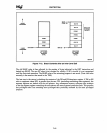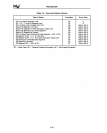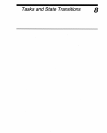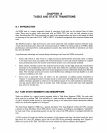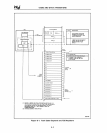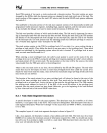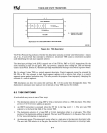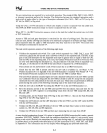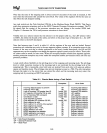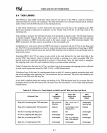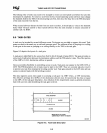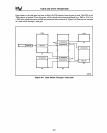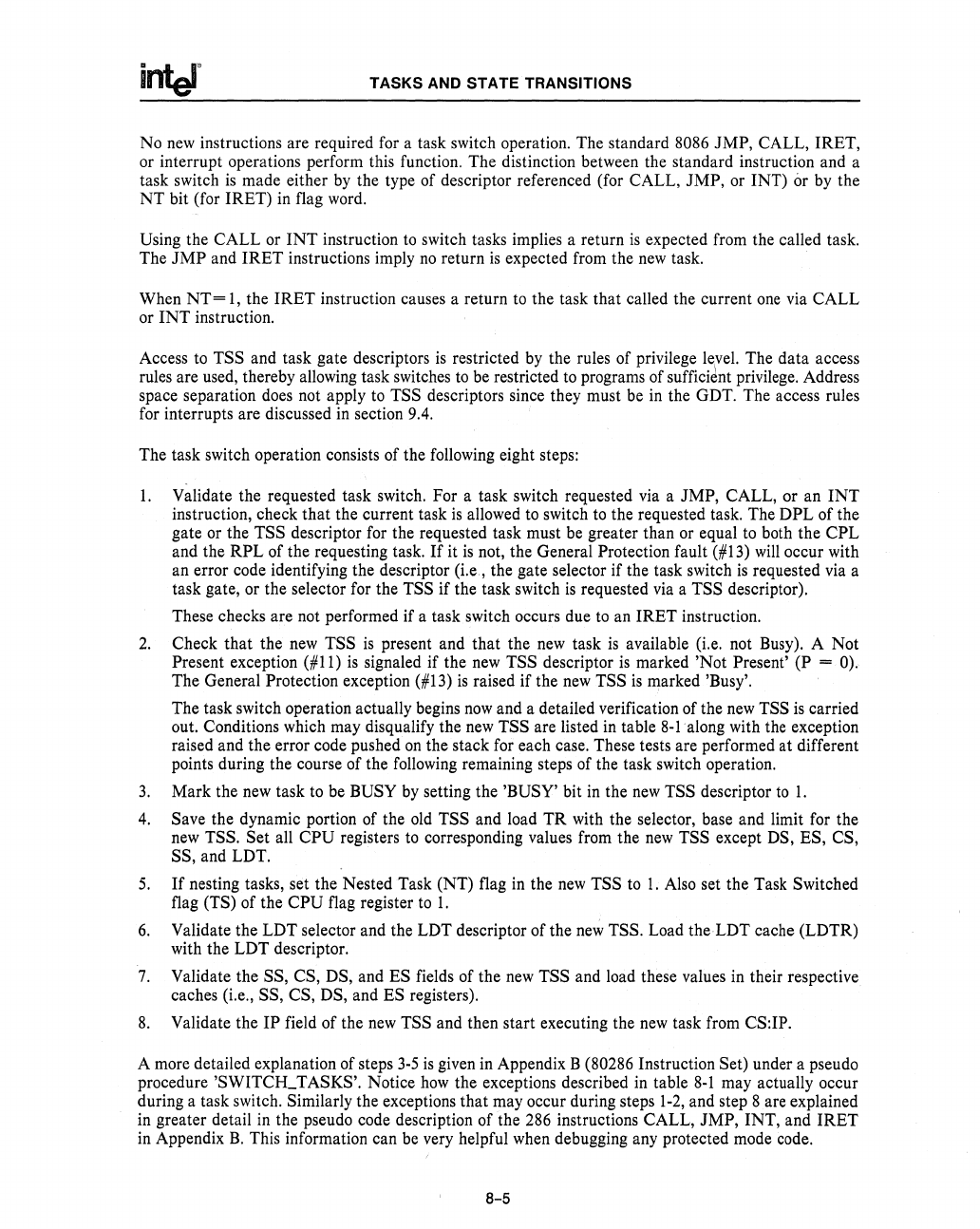
TASKS AND STATE TRANSITIONS
No
new
instructions are required for a task switch operation. The standard 8086 JMP, CALL, IRET,
or interrupt operations perform this function. The distinction between the standard instruction and a
task switch
is
made either
by
the type of descriptor referenced (for CALL, JMP, or INT) or by the
NT
bit (for IRET)
in
flag word.
Using the CALL or
INT
instruction
to
switch tasks implies a return
is
expected from the calIed task.
The
JMP
and
IRET
instructions imply
no
return
is
expected from the
new
task.
When
NT=
1,
the IRET instruction causes a return
to
the task that calIed the current
one
via CALL
or
INT
instruction.
Access
to
TSS and task gate descriptors
is
restricted
by
the rules of privilege level. The data access
rules are used, thereby
alIowing
task switches
to
be
restricted
to
programs of sufficidnt privilege. Address
space separation does not apply
to
TSS descriptors since they must be in the GDT. The access rules
for interrupts are discussed
in
section 9.4.
The task switch operation consists of the
folIowing
eight steps:
1.
Validate the requested task switch. For a task switch requested via a JMP, CALL, or an
INT
instruction, check that the current task
is
alIowed
to
switch
to
the requested task. The DPL of the
gate or the
TSS descriptor for the requested task must
be
greater than or equal
to
both the CPL
and the RPL of the requesting task. If it
is
not, the General Protection fault (#13)
will
occur with
an error code identifying the descriptor (i.e., the gate selector if the task switch
is
requested via a
task gate, or the selector for the
TSS if the task switch
is
requested
via
a TSS descriptor).
These checks are not performed if a task switch occurs due
to
an
IRET instruction.
2.
Check that the
new
TSS
is
present and that the
new
task
is
available
(Le.
not Busy). A Not
Present exception (#11)
is
signaled if the
new
TSS descriptor
is
marked 'Not Present' (P = 0).
The General Protection exception (#13)
is
raised if the
new
TSS
is
ll1arked
'Busy'.
The task switch operation actualIy begins
now
and a detailed verification of the
new
TSS
is
carried
out. Conditions which may disqualify the
new
TSS are listed
in
table
8-1
along with the exception
raised and the error code pushed
on
the stack for each case. These tests are performed at different
points during the course of the
folIowing
remaining steps of the task switch operation.
3.
Mark the
new
task to
be
BUSY
by
setting the 'BUSY' bit
in
the
new
TSS descriptor
to
1.
4.
Save the dynamic portion of the old TSS and load
TR
with the selector, base and limit for the
new
TSS. Set
alI
CPU registers
to
corresponding values from the
new
TSS except DS, ES, CS,
SS,
and LDT.
5.
If
nesting tasks, set the Nested Task (NT) flag
in
the
new
TSS
to
1.
Also
set the Task Switched
flag
(TS) of the CPU flag register
to
1.
6.
Validate the LDT selector and the LDT descriptor of the
new
TSS. Load
theLDT
cache (LDTR)
with the LDT descriptor.
7.
Validate the SS, CS, DS, and ES fields of the
new
TSS and load these values in their respective
caches
(Le.,
SS, CS, DS, and ES registers).
8.
Validate the IP field of the
new
TSS and then start executing the
new
task from CS:IP.
A more detailed explanation of steps
3-5
is
given in Appendix B (80286 Instruction Set) under a pseudo
procedure
'SWITCH_TASKS'. Notice
how
the exceptions described in table
8-1
may actualIy occur
during a task switch. Similarly the exceptions that may occur during steps
1-2,
and step 8 are explained
in greater detail in the pseudo code description of the 286 instructions CALL,
JMP, INT, and IRET
in Appendix
B.
This information can
be
very helpful when debugging any protected mode code.
8-5



